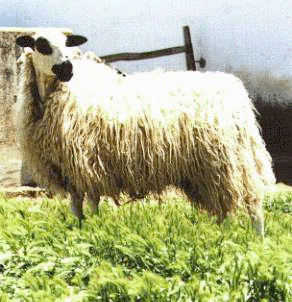Descendants of the Iberian Churra

Origin
Navajo-Churro sheep are descended from the Churra, an ancient
Iberian breed. Although secondary to the Merino, the Churra (later
corrupted to "Churro" by American frontiersmen) was prized by
the Spanish for its remarkable hardiness, adaptability and fecundity.
The Churra was the very first breed of domesticated sheep in the
New World. Its importation to New Spain by the Spanish dates back
to the 16th century where it was used to feed and clothe the armies
of the conquistadors and Spanish settlers.
History
By the 17th century the Churro had become the mainstay of Spanish
ranches and villages along the upper Rio Grande Valley. Native
Indians acquired flocks of Churro for food and fiber through raids
and trading. Within a century, herding and weaving had become
a major economic asset for the Navajo. It was from Churro wool
that the early Rio Grande, Pueblo, and Navajo textiles were woven
-- a fleece admired by collectors for its luster, silky hand,
variety of natural colors and durability.
Livestock, including sheep, came in 1494 when Spain established
colonies in the Caribbean and then in Mexico. Colonization expanded
gradually into Nuevo España which is now the Southwest of the
United States. In 1540, following the initial expedition of Cortez
in 1538, Coronado searched for the Cities of Gold expending 5,000
head of sheep on the journey. The few left in New Mexico were
not heard of again. Don Juan de Oñate, in 1598, brought settlers
and 2,900 sheep that formed the initial colonization of the Southwest.
Spanish ranches prospered in Texas, New Mexico and Arizona with
flocks numbering in the thousands. Many sheep were trailed back
to Mexico to feed mining towns and they supplied the growing population
of the Southwest. In 1849 when gold was discovered in California,
churros were trailed west to feed the Gold Fever.
During this period of Spanish colonization, Pueblo Indians were
hired and enslaved to herd livestock and to weave textiles. The
Dine’ (the Navajo people), living on the edge of Spanish occupation,
acquired a few sheep and horses by trades and by raids on outlying
settlements. Following the turmoil of 1680 when the Pueblos revolted
against Spanish oppression, the Navajos acquired more sheep, as
did the Apaches. The Apaches ate the sheep they took but the Navajos
nurtured their acquisitions and expanded their flocks.
As European settlers came west and the demand arose for fine wool
in the American textile industry, the churros were "graded up"
by crossing with Merino and English longwools. However, some churros
remained in the remote Hispanic villages, among the isolated Navajos
and on the West Coast. These isolated flocks eventually formed
the landrace sheep, the Navajo-Churro, named to recognize Spanish
and Navajo influence.
Because the Navajos resisted the settlers who were encroaching
on Dine’ homelands, the U.S. government ordered military actions
led by Kit Carson and John Carlton with instructions to destroy
Navajo orchards and flocks. There was much bloodshed and in 1865
approximately 9,000 Navajos were forced on the Long Walk of 300
miles to an interment camp at Bosque Redondo, New Mexico. Terrible
conditions here caused the death of many people and their livestock.
Some Navajos escaped capture and hid with their sheep in remote
canyons of New Mexico and Arizona. After three years, the Navajo
were returned to their homeland and were issued two "native" sheep
per person from Hispanic.flocks.
The Navajo were such good weavers and shepherds that their mixed
flocks grew to 574,821 sheep by l930. The large number of sheep,
goats, horses and cattle was problematic for the severe drought
conditions of the 1930’s, so the U.S. government conducted a stock
reduction. Some stock was purchased for $1-1.50 but the reduction
progressed so slowly that roughly 30% of each household’s sheep,
goats and horses were slaughtered by government agents and thrown
into arroyos or burned. This terrifying Stock Reduction is still
vivid in Navajo memory.
 .....
.....